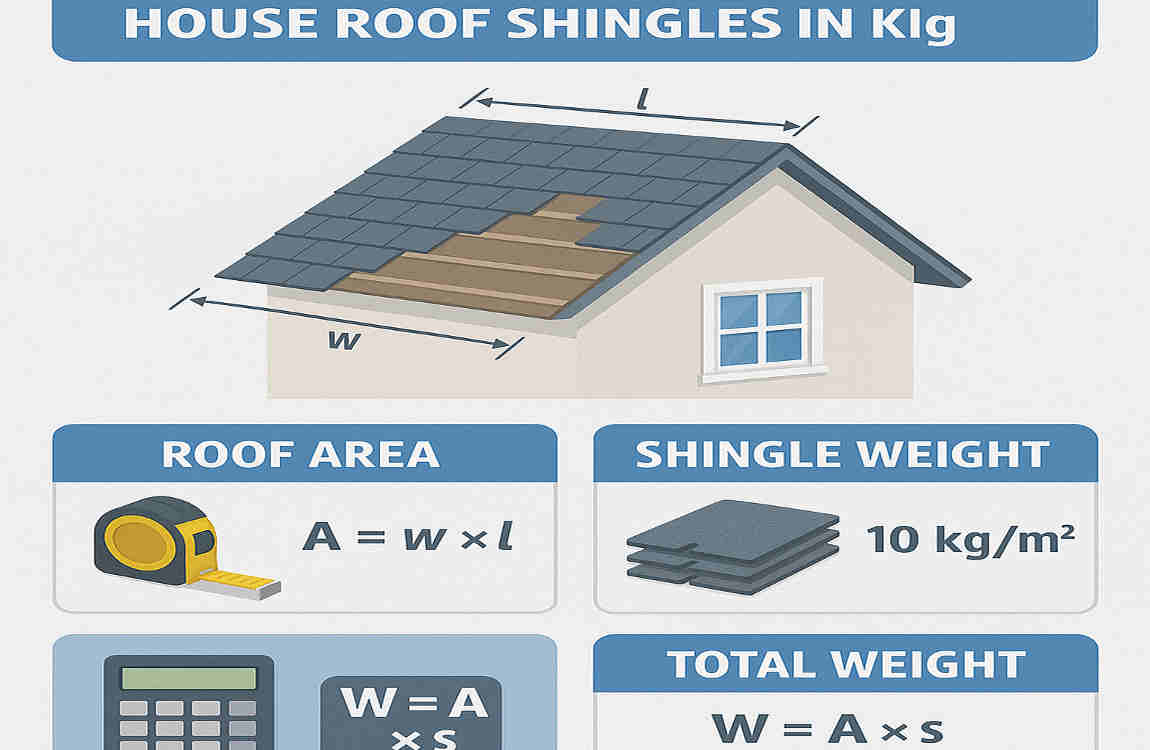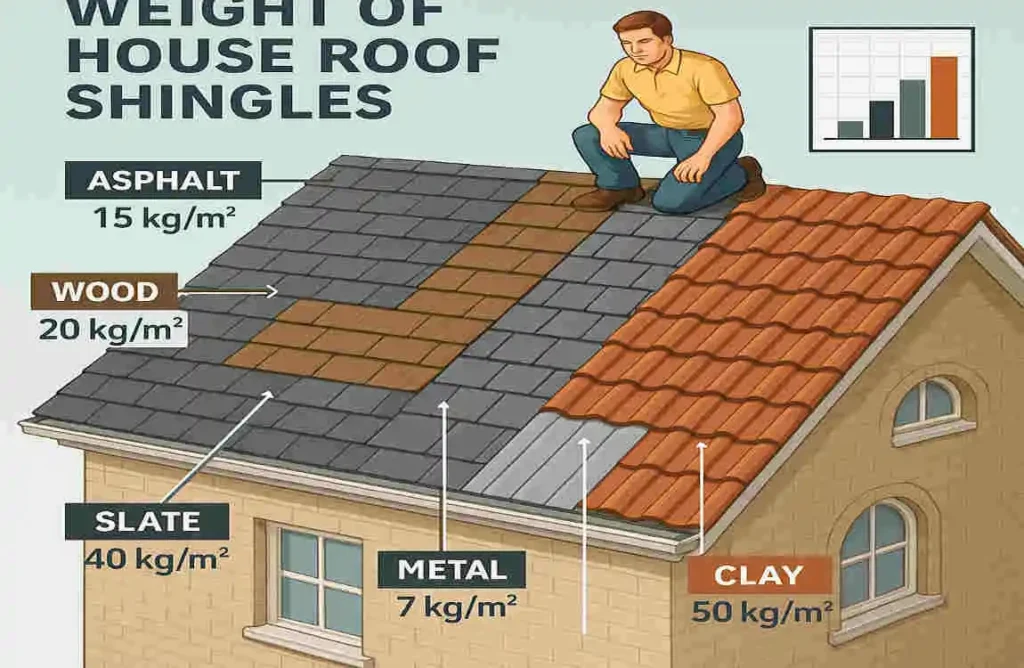Have you ever wondered about the weight sitting on top of your home? House shingles are more than just protective layers that shield your home from rain, snow, and sun. They’re carefully engineered materials that form the first line of defence for your roof structure. Understanding their weight is crucial for making informed decisions about your home.
When we discuss the weight of house shingles in kilograms, we’re addressing a fundamental question that impacts everything from structural design to installation costs. Whether you’re a homeowner planning a renovation, a builder calculating load requirements, or an architect designing a new structure, knowing the precise weight of roofing materials in kilograms is essential.
Why Shingle Weight Matters

Structural Integrity
The weight of your shingles directly impacts your home’s structural integrity. Every roof is designed with specific load-bearing capacities in mind. When you choose shingles, you’re essentially deciding how much weight your roof structure needs to support for decades to come.
Building codes across different regions specify maximum allowable roof loads. These guidelines ensure that your home’s framework can safely support not just the shingles themselves, but also additional loads from snow, wind, and maintenance activities. Exceeding these limits can lead to sagging, structural damage, or even catastrophic failure.
Your roof’s trusses, rafters, and decking all work together to distribute the weight of shingles evenly. Heavier materials, such as slate or clay tiles, require more robust support systems compared to lighter options, like metal or asphalt shingles. This is why understanding shingle weight becomes critical during both new construction and renovation projects.
Transportation and Installation
Consider the logistics of transporting shingles from the manufacturer to your roof. Transportation costs increase significantly with heavier materials. A truck carrying clay tiles will transport fewer squares than one loaded with asphalt shingles, directly impacting your project’s bottom line.
Installation methods also vary based on weight. Lighter shingles allow installers to carry more material up ladders at once, speeding up the installation process. Heavier materials often require mechanical lifting equipment, which adds to labour costs and installation time.
The physical demands on installation crews increase with the handling of heavier materials. This translates to higher labour costs and potentially longer project timelines. Some roofing contractors even charge premium rates for installing particularly heavy materials due to the additional effort and equipment required for the installation.
Environmental and Cost Factors
When it’s time to replace your roof, the weight of old shingles becomes a disposal concern. Heavier materials result in higher disposal fees at recycling centres or landfills. Many facilities charge by weight, so those beautiful but heavy slate shingles could cost significantly more to remove than lighter alternatives.
Shipping costs from manufacturers to suppliers are directly tied to weight. These costs get passed on to consumers, making heavier shingles more expensive even before considering installation. International shipping of speciality tiles can significantly increase the costs of your roofing project.
Energy efficiency also connects to shingle weight. Heavier materials often provide better thermal mass, helping regulate indoor temperatures. However, they also require stronger, usually more complex support structures that can impact your home’s overall energy performance.
Types of House Shingles and Their Weights
Asphalt Shingles
Asphalt shingles remain the most popular roofing choice across many regions, and understanding their weight variations helps explain why. These versatile materials combine affordability with reasonable durability, making them ideal for a wide range of climates and budgets.
You may also read (how to create a slope for your flat house roof).
Types of Asphalt Shingles
Three-tab shingles represent the most basic and lightweight option. These flat, uniform shingles create a clean, traditional appearance. Their simple design keeps weight to a minimum while still providing adequate protection.
Architectural shingles, also called dimensional shingles, add depth and visual interest to your roof. Their multi-layered construction creates shadow lines that mimic more expensive materials. This added material naturally increases their weight compared to three-tab options.
Luxury shingles push the boundaries of what asphalt can achieve. These premium products often replicate the appearance of slate or wood shakes. Their sophisticated designs and enhanced durability come with an additional weight that approaches that of some traditional materials.
Average Weight per Square Meter and Bundle in kg
Shingle TypeWeight per m² (kg)Weight per Bundle (kg)
Three-tab 10-12 25-32
Architectural 12-15 32-40
Luxury 15-20 45-55
These weights can vary slightly between manufacturers, but they provide reliable estimates for planning purposes. Please note that moisture, age, and specific product features can impact actual weights.
Wood Shingles and Shakes
Wood shingles bring natural beauty and traditional charm to any home. Cedar remains the most popular choice, prized for its natural resistance to insects and decay. Pine and other species offer more affordable alternatives with varying durability characteristics.
The weight of wood shingles typically ranges from 15 to 18 kg per square meter. However, this can fluctuate significantly based on several factors. Thickness plays a major role – hand-split shakes are substantially thicker and heavier than machine-cut shingles.
Wood species directly impact weight. Dense hardwoods weigh more than softer species, such as cedar. Moisture content presents another variable. Freshly installed wood shingles may weigh 10-15% more than fully dried materials. This is why proper ventilation becomes crucial for wood roofs.
Treatment processes also add weight. Fire-retardant treatments and preservatives increase the overall mass of wood shingles. While these treatments enhance safety and longevity, they must be factored into structural calculations to ensure optimal performance.
Clay and Concrete Tiles
Clay and concrete tiles are among the heaviest roofing options available. Their substantial weight reflects their durability and longevity – these materials can last over a century with proper maintenance.
Clay tiles undergo a firing process that creates their characteristic durability and colour. Traditional barrel tiles can weigh between 35 and 60 kg per square meter. Flat clay tiles tend toward the lower end of this range, while speciality shapes and thicker profiles push weights higher.
Concrete tiles offer a similar aesthetic to clay, but with different manufacturing processes. These tiles typically weigh 40-60 kg per square meter. The density of concrete and any added colourants or coatings influence the final weight.
The weight of these tiles presents unique challenges. Existing structures often require reinforcement before tile installation can occur. New construction must incorporate stronger framing from the design phase to ensure optimal performance. Despite these considerations, many homeowners find the longevity and beauty of tiles worth the additional structural requirements.
Metal Shingles
Metal shingles revolutionise roofing by combining durability with surprisingly lightweight properties. These modern materials challenge traditional assumptions about what makes a good roof.
Aluminium shingles lead the lightweight category, typically weighing just 7-8 kg per square meter. This minimal weight allows installation over existing roofs in many cases, eliminating tear-off costs and disposal concerns.
Steel shingles add slightly more weight at 8-10 kg per square meter. The additional mass comes from steel’s higher density and protective coatings that prevent rust. Galvanised and stone-coated steel options may weigh slightly more due to their enhanced finishes.
Copper shingles represent the premium metal option. While heavier than aluminium, they still weigh significantly less than traditional materials at approximately 9-11 kg per square meter. Their natural patina development and extreme longevity justify the investment for many homeowners.
The lightweight nature of metal shingles opens possibilities for older homes. Structures that can’t support heavy tiles often accommodate metal alternatives that provide similar aesthetics with a fraction of the weight.
Slate Shingles
Slate shingles embody timeless elegance and exceptional durability. Natural slate has protected buildings for centuries, and modern synthetic alternatives bring this classic look to more homes.
Natural slate varies considerably in weight, depending on its thickness and quarry source. Welsh slate tends to be thinner and lighter, while Vermont slate often comes in thicker cuts. Weights typically range from 25-40 kg per square meter, with some speciality products exceeding these figures.
Synthetic slate offers a lighter alternative while maintaining an authentic appearance. These engineered products typically weigh 12-18 kg per square meter, less than half that of natural slate. Advanced manufacturing techniques enable the creation of products that are virtually indistinguishable from natural stone.
The substantial weight of natural slate demands careful structural evaluation. Many older homes with slate roofs were specifically built to handle these loads. Modern construction must incorporate appropriate support systems from the foundation to the top.
Detailed Weight Comparison Table
Understanding how different shingle materials compare helps put individual weights into perspective. This comprehensive comparison shows the dramatic weight differences between roofing options:
TypeWeight per m² (kg)Typical Roof Weight (kg, 185 m²)
Asphalt (3-tab) 10-12 1,850-2,220
Asphalt (Architect.) 12-15 2,220-2,775
Wood Shingles 15-18 2,775-3,330
Clay Tiles 35-60 6,475-11,100
Concrete Tiles 40-60 7,400-11,100
Metal Shingles 7-10 1,295-1,850
Slate Shingles 25-40 4,625-7,400
Note: Always consult the manufacturer’s specifications for precise values.
These figures illustrate why material selection significantly impacts various aspects of your roofing project. The difference between the lightest metal shingles and the heaviest concrete tiles can exceed 8,000 kg for an average-sized roof!
Factors Affecting Shingle Weight
Several variables influence the actual weight of shingles beyond their base material. Understanding these factors helps you make more accurate calculations for your specific situation.
Material composition forms the foundation of shingle weight. Manufacturers adjust formulas to strike a balance between durability, cost, and weight. Premium products often incorporate additional materials that enhance performance but increase mass.
Thickness and shape significantly impact weight. Dimensional shingles with multiple layers weigh more than flat alternatives. Curved tiles require more material than flat profiles, which adds to their overall weight.
Coatings and finishes contribute additional mass. Reflective coatings, algae-resistant treatments, and colour granules all add weight. While individually minor, these additions collectively add up across an entire roof.
Moisture retention particularly affects organic materials. Wood shingles can absorb significant water during rain, temporarily increasing roof loads. Old asphalt shingles may also retain moisture as they deteriorate.
Age and degradation alter original weights. Asphalt shingles lose granules over time, which slightly reduces their weight. Conversely, accumulated dirt, moss, and debris add mass to ageing roofs.
How to Calculate the Total Weight of House Shingles in kg

Step-by-Step Guide
Calculating your roof’s total shingle weight doesn’t require advanced mathematics. Follow these straightforward steps for accurate results:
Step 1: Measure your roof’s total area in square meters. Include all surfaces that will receive shingles. Don’t forget dormers, extensions, and complex architectural features.
Step 2: Identify your chosen shingle’s weight per square meter. Manufacturer specifications provide these figures. When in doubt, use the higher end of weight ranges for safety.
Step 3: Multiply the roof area by the weight per square meter. This provides the basic weight of shingles required.
Step 4: Add 5-10% for waste, overlaps, and packaging. Professional installers typically order extra material to account for cuts, damaged pieces, and future repairs.
You may also read (transform your home with simple garden landscaping ideas).
Example Calculation
Let’s walk through a real-world example to illustrate the process:
Given information:
- Roof area: 185 m²
- Shingle choice: Architectural asphalt at 13 kg/m²
- Waste factor: 7%
Basic calculation: 185 × 13 = 2,405 kg
Adding waste factor: 2,405 × 1.07 = 2,573 kg
Final result: You’ll need approximately 2,573 kg of shingles for this project.
This calculation helps determine transportation needs, structural requirements, and disposal planning for old materials.
Regional Differences: Shingle Weights Around the World
Roofing preferences vary dramatically across different regions, influenced by climate, tradition, and material availability. These variations directly impact typical shingle weights in other areas.
North American homes predominantly feature asphalt shingles, keeping average roof weights relatively low. The widespread availability of asphalt products and moderate climate in many regions make these lightweight options practical and economical.
European architecture often incorporates heavier materials, such as clay tiles and natural slate. Historical building traditions and stricter aesthetic regulations in many European cities maintain demand for these traditional materials despite their weight.
Asian markets are showing an increasing diversity in roofing choices. Traditional heavy clay tiles remain popular in many areas, while rapidly developing regions increasingly adopt lighter modern materials for new construction.
Climate plays a crucial role in material selection. Hurricane-prone regions often mandate heavier materials or enhanced fastening systems. Areas with heavy snowfall must balance the desire for durable materials with total load considerations.
Local availability significantly impacts choices. Regions near slate quarries naturally feature more slate roofs. Areas with established clay tile manufacturing maintain strong traditions of tile roofing. Import costs can make exotic materials prohibitively expensive, regardless of their technical merits.
Common Misconceptions
“Lighter shingles are always better.” This oversimplification ignores the benefits of heavier materials. While lighter shingles reduce structural requirements, heavier options often provide superior durability, sound dampening, and thermal mass. The “best” choice depends on your specific needs, climate, and budget.
“Shingle weight doesn’t affect home insurance.” Insurance companies absolutely consider roofing materials when calculating premiums. Heavier, more durable materials, such as slate or tile, often qualify for discounts due to their resistance to wind and hail damage. However, the increased replacement cost may offset these savings.
“All asphalt shingles weigh the same.” Asphalt shingle weights vary significantly between products. Basic three-tab shingles weigh considerably less than premium architectural options. Even within categories, different manufacturers produce shingles with varying weights based on their specific formulations and designs.
How Manufacturers Specify and Label Shingle Weight
Understanding manufacturer specifications helps you compare products accurately. Different companies use various methods to communicate weight information.
Product labels typically show weight per bundle or square (100 square feet). Converting these figures to metric requires attention to detail. One square equals approximately 9.29 square meters, essential for accurate conversions.
Regional differences in labelling can confuse consumers. North American manufacturers often use imperial measurements, whereas European and Asian producers typically specify weights in metric units. Always verify which system a manufacturer uses.
Standardisation efforts by industry organisations aim to facilitate easier comparisons. However, variations persist between manufacturers and regions. When in doubt, contact manufacturers directly for clarification on their weight specifications.
Tips for Homeowners
Choosing the right shingle weight for your home involves balancing multiple factors. Consider these practical tips for making informed decisions:
Climate considerations should drive material selection. High-wind areas benefit from heavier materials or enhanced fastening systems. Regions with heavy snowfall must carefully balance material weight with total load capacity.
Structural evaluation becomes critical when changing material types. Switching from lightweight asphalt to heavy tile requires professional assessment. Even within material categories, significant weight increases warrant structural review.
Maintenance implications vary with shingle weight. Lighter materials may require more frequent replacement but prove easier and cheaper to maintain. Heavier materials often last longer but cost more when repairs become necessary.
Future planning affects material choice. If you plan to install solar panels, consider their additional weight when selecting shingles. Planning for eventual replacement also matters – will future technology offer lighter alternatives?
You may also read (what are the best roof tiles for your house).

